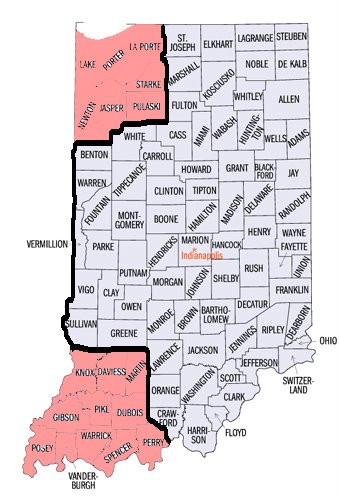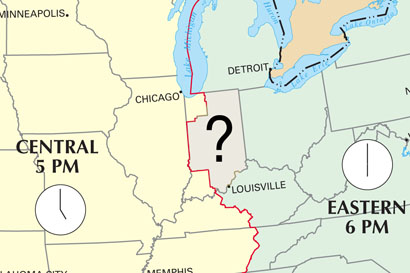
We’ve mentioned how an earlier sunrise can help get you up and out of bed, but more sunshine hours can have some negatives as well. It’s not much, but it’s something! Waking up to a sunrise, as opposed to the sun rising an hour after you’ve awakened, can make at least a small difference.


Though for the most part there is nothing that can be done about the length of days as our earth moves away from the sun, moving the hours of daylight back can definitely mitigate the effects slightly. But for those traveling through, especially if they are headed to Indy from a different part of the state, it can get extremely confusing. If you live in Indiana, this seems the most reasonable way to divide the state. Being in the same time zone as this nearby large metropolis was the most logical option. The cities in northwestern Indiana are on Central Time because they are so close to Chicago. Louis, Springfield, and Nashville, so it makes sense for this part of the state to be on Central Time. The “toe of the boot,” or the southwestern end of the state, is closer to large cities like St. Most of the state is on Eastern Time, keeping it in the same time zone as many other large, Midwestern cities, such as Columbus, Louisville, and Detroit. But because Indiana is so long, there are many different cities and lifestyles within it, just like California. Seemingly, drawing the line with state borders is the most intuitive option. Once Indiana became a Daylight Savings state, outlining the borders for the two local time zones wasn’t exactly easy. Where to Draw Indiana’s ‘Time Zone’ Lines: A large portion of Indiana’s population lives in this populated area, meaning all of these suburbs and towns are in a different time zone than the state capitol. Most of The Region is about three hours from Indianapolis, not far enough to usually merit a time change. The Indiana side of the area surrounding Chicago, known to Hoosiers as “The Region,” is also on Central Time. Though relatively close in distance, Indianapolis is an hour ahead of Evansville, and the rest of the southwestern portion of the state where the Wabash meets the Ohio River. For instance Evansville, Indiana, nearly the southernmost city in Indiana, is a short three hour drive from Indianapolis, via I-69. It’s more about the lines of these borders, however when it comes to the inconvenience. That’s a lot of space to cover, so it’s understandable that you might cross time zone borders. Indiana is a long state it takes around six hours to travel from top to bottom. When Indiana residents are traveling within the state, or trying to watch something broadcast from Indianapolis, it’s a constant pain to remember the time zone difference. Most of the state is on Eastern Time (80 out of 92 counties,) but some of the most populated parts of the state are on Central Time. To make it even more confusing, the state capital and seat of the state government is on Eastern Time, while much of the state is not. Effectively, it’s almost more like three time zones, because both the northern and southern portions of the state are on Central Time, with a large section cut out of the middle that is on Eastern Time. Indiana is one of the thirteen states in the U.S. I’ve outlined some of the ways in which the time zones in Indiana can get muddy, and hopefully can give you some insight into what the reality of the time difference looks like for a local. After all, if you’re living in the Indy Metro Area, it’s in the same time zone as most of the rest of the state, so why should the other parts of the state three hours away from you affect you? Unfortunately, think again, because it can and will get confusing at some point. It also might not seem like a big deal at all.

You might have looked at a map already and realized that there are portions of Indiana on both Central Time and Eastern Time. But one of the biggest controversies about living in Indianapolis that you probably won’t consider until you live there is the multiple time zones within the state of Indiana. Or which neighborhoods are best to live in for your particular lifestyle. Like how brutally cold the winds are in the prairie geography of central Indiana. But there are also less obvious things to consider, caveats only a local can let you in on. You have the obvious factors, like schools and employment opportunities, or where to look when buying a home. There are plenty of things to think about when you are considering living in Indianapolis.


 0 kommentar(er)
0 kommentar(er)
